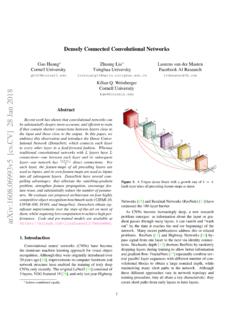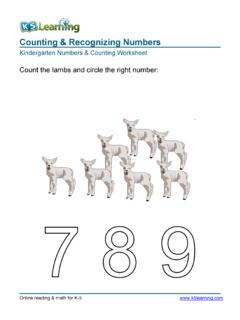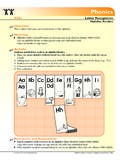Transcription of Deep Residual Learning for Image Recognition - …
1 Deep Residual Learning for Image RecognitionKaiming HeXiangyu ZhangShaoqing RenJian SunMicrosoft Research{kahe, v-xiangz, v-shren, neural networks are more difficult to train. Wepresent a Residual Learning framework to ease the trainingof networks that are substantially deeper than those usedpreviously. We explicitly reformulate the layers as learn-ing Residual functions with reference to the layer inputs, in-stead of Learning unreferenced functions. We provide com-prehensive empirical evidence showing that these residualnetworks are easier to optimize, and can gain accuracy fromconsiderably increased depth.}
2 On the ImageNet dataset weevaluate Residual nets with a depth of up to 152 layers 8 deeper than VGG nets [41] but still having lower complex-ity. An ensemble of these Residual nets achieves erroron the ImageNettestset. This result won the 1st place on theILSVRC 2015 classification task. We also present analysison CIFAR-10 with 100 and 1000 depth of representations is of central importancefor many visual Recognition tasks. Solely due to our ex-tremely deep representations, we obtain a 28% relative im-provement on the COCO object detection dataset.
3 Deepresidual nets are foundations of our submissions to ILSVRC& COCO 2015 competitions1, where we also won the 1stplaces on the tasks of ImageNet detection, ImageNet local-ization, COCO detection, and COCO IntroductionDeep convolutional neural networks [22, 21] have ledto a series of breakthroughs for Image classification [21,50, 40]. Deep networks naturally integrate low/mid/high-level features [50] and classifiers in an end-to-end multi-layer fashion, and the levels of features can be enrichedby the number of stacked layers (depth).
4 Recent evidence[41, 44] reveals that network depth is of crucial importance,and the leading results [41, 44, 13, 16] on the challengingImageNet dataset [36] all exploit very deep [41] models,with a depth of sixteen [41] to thirty [16]. Many other non-trivial visual Recognition tasks [8, 12, 7, 32, 27] have also1 # 1020iter. (1e4)training error (%) 012345601020iter. (1e4)test error (%) 56-layer20-layer56-layer20-layerFigure 1. Training error (left) and test error (right) on CIFAR-10with 20-layer and 56-layer plain networks. The deeper networkhas higher training error, and thus test error.
5 Similar phenomenaon ImageNet is presented in Fig. benefited from very deep by the significance of depth, a question arises:Islearning better networks as easy as stacking more layers?An obstacle to answering this question was the notoriousproblem of vanishing/exploding gradients [1, 9], whichhamper convergence from the beginning. This problem,however, has been largely addressed by normalized initial-ization [23, 9, 37, 13] and intermediate normalization layers[16], which enable networks with tens of layers to start con-verging for stochastic gradient descent (SGD) with back-propagation [22].
6 When deeper networks are able to start converging, adegradationproblem has been exposed: with the networkdepth increasing, accuracy gets saturated (which might beunsurprising) and then degrades ,such degradation isnot caused by overfitting, and addingmore layers to a suitably deep model leads tohigher train-ing error, as reported in [11, 42] and thoroughly verified byour experiments. Fig. 1 shows a typical degradation (of training accuracy) indicates that notall systems are similarly easy to optimize. Let us consider ashallower architecture and its deeper counterpart that addsmore layers onto it.
7 There exists a solutionby constructionto the deeper model: the added layers areidentitymapping,and the other layers are copied from the learned shallowermodel. The existence of this constructed solution indicatesthat a deeper model should produce no higher training errorthan its shallower counterpart. But experiments show thatour current solvers on hand are unable to find solutions that1 [ ] 10 Dec 2015identityweight layerweight layerrelureluF(x) + xxF(x)xFigure 2. Residual Learning : a building comparably good or better than the constructed solution(or unable to do so in feasible time).
8 In this paper, we address the degradation problem byintroducing adeep Residual of hoping each few stacked layers directly fit adesired underlying mapping, we explicitly let these lay-ers fit a Residual mapping. Formally, denoting the desiredunderlying mapping asH(x), we let the stacked nonlinearlayers fit another mapping ofF(x) :=H(x) x. The orig-inal mapping is recast intoF(x)+x. We hypothesize that itis easier to optimize the Residual mapping than to optimizethe original, unreferenced mapping. To the extreme, if anidentity mapping were optimal, it would be easier to pushthe Residual to zero than to fit an identity mapping by a stackof nonlinear formulation ofF(x)+xcan be realized by feedfor-ward neural networks with shortcut connections (Fig.)
9 2).Shortcut connections [2, 34, 49] are those skipping one ormore layers. In our case, the shortcut connections simplyperformidentitymapping, and their outputs are added tothe outputs of the stacked layers (Fig. 2). Identity short-cut connections add neither extra parameter nor computa-tional complexity. The entire network can still be trainedend-to-end by SGD with backpropagation, and can be eas-ily implemented using common libraries ( , Caffe [19])without modifying the present comprehensive experiments on ImageNet[36] to show the degradation problem and evaluate ourmethod.
10 We show that: 1) Our extremely deep Residual netsare easy to optimize, but the counterpart plain nets (thatsimply stack layers) exhibit higher training error when thedepth increases; 2) Our deep Residual nets can easily enjoyaccuracy gains from greatly increased depth, producing re-sults substantially better than previous phenomena are also shown on the CIFAR-10 set[20], suggesting that the optimization difficulties and theeffects of our method are not just akin to a particular present successfully trained models on this dataset withover 100 layers, and explore models with over 1000 the ImageNet classification dataset [36], we obtainexcellent results by extremely deep Residual nets.

![arXiv:0706.3639v1 [cs.AI] 25 Jun 2007](/cache/preview/4/1/3/9/3/1/4/b/thumb-4139314b93ef86b7b4c2d05ebcc88e46.jpg)
![arXiv:1301.3781v3 [cs.CL] 7 Sep 2013](/cache/preview/4/d/5/0/4/3/4/0/thumb-4d504340120163c0bdf3f4678d8d217f.jpg)
![@google.com arXiv:1609.03499v2 [cs.SD] 19 Sep 2016](/cache/preview/c/3/4/9/4/6/9/b/thumb-c349469b499107d21e221f2ac908f8b2.jpg)












